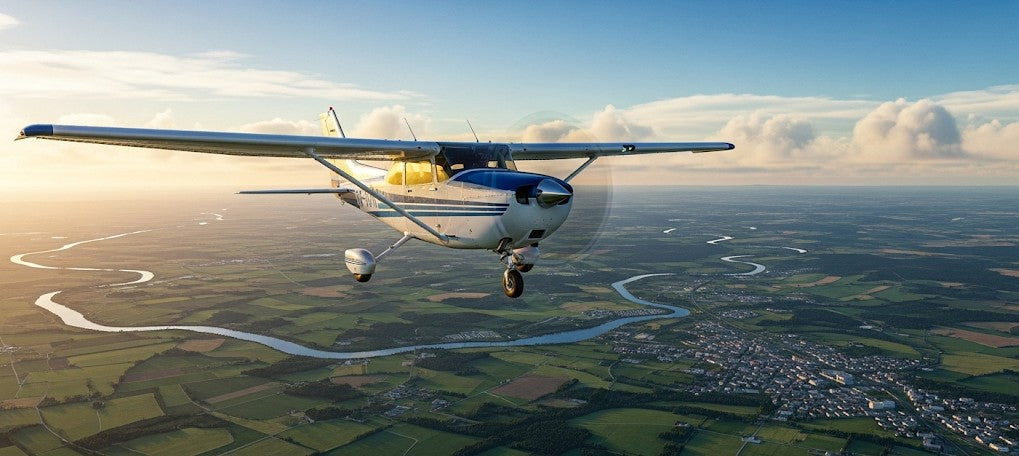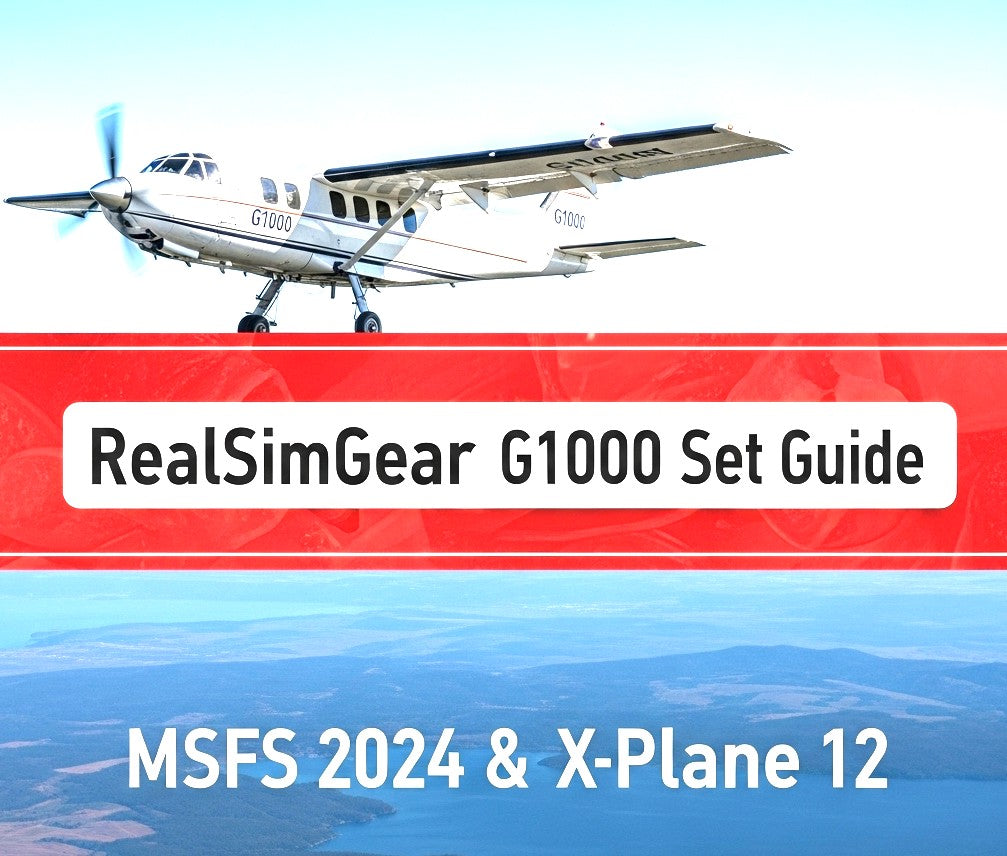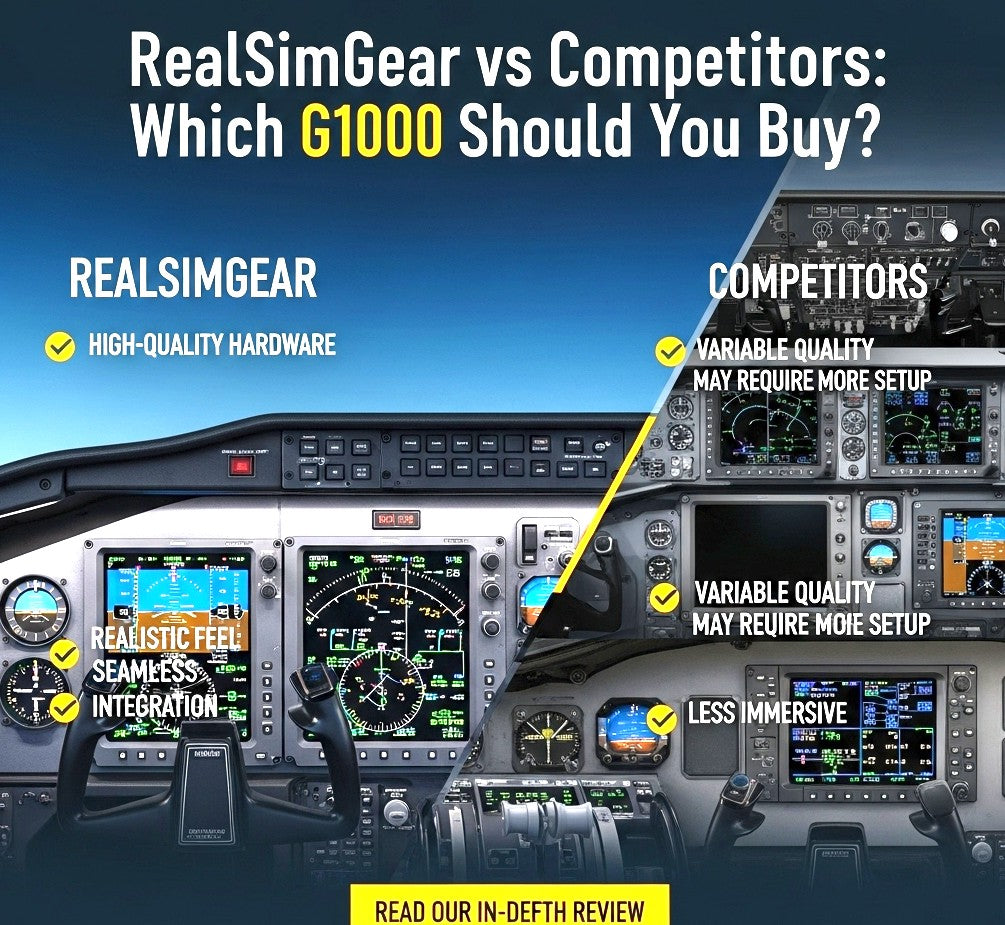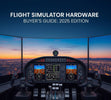
Flight Simulator Hardware Buyer’s Guide: 2025 Edition
- , door Mark Verwoert
- 16 min lezen
This comprehensive guide reveals exactly which flight simulator hardware delivers authentic flying experiences and accelerates real-world pilot skills. Whether you're training for your PPL, building your first home cockpit, or upgrading to airline-grade controls, our pilot-tested recommendations will transform your simulation from gaming to genuine flight training.
What you'll learn: Hardware selection frameworks, budget allocation strategies, compatibility guides, and step-by-step setup processes that professional flight schools use for simulator-based training.
What Flight Sim Hardware Do I Actually Need to Start Flying?
The foundation of realistic flight simulation isn't graphics or scenery—it's authentic control inputs that build proper muscle memory. Professional flight training programs prioritize three core components that directly transfer to real aircraft:
Essential Hardware Priority List:
- Primary flight controls (yoke or joystick) - 40% of budget
- Power management (throttle quadrant) - 30% of budget
- Directional control (rudder pedals) - 20% of budget
- Mounting system (stability platform) - 10% of budget
Core Flight Simulator Hardware Components (2025 Specifications)
| Hardware | Function | Precision Level | Real-World Transfer | Price Range | Best Models |
|---|---|---|---|---|---|
| Yoke | Control wheel emulation | ±0.1° accuracy | Excellent for GA/Airlines | €250–€600 | MOZA MFY (Hall sensors) |
| Joystick (HOTAS) | Sidestick/fighter control | ±0.05° accuracy | Perfect for Airbus/Military | €100–€450 | Thrustmaster T16000M FCS |
| Throttle Quadrant | Power/mixture control | 16-bit resolution | Critical for multi-engine | €200–€800 | MOZA MTP (Metal construction) |
| Rudder Pedals | Yaw axis/differential braking | 12-bit+ resolution | Essential for crosswinds | €200–€600 | Thrustmaster TPR / VirtualFly RUDDO+ |
| Mounts & Cockpits | Stability & ergonomics | N/A | Reduces fatigue/improves precision | €150–€1,200+ | FlightSimZone certified rigs |
Yoke vs Joystick: Which Controls Match Your Aircraft Type?
When to Choose a Yoke
Best for: Cessna, Piper, Boeing, general aviation training
Advantages:
- Matches 70% of training aircraft control layout
- Natural two-handed operation for stability
- Authentic feel for instrument approaches and crosswind landings
- Direct transfer to flight school aircraft
MOZA MFY Yoke Hall effect sensors provide 0.1-degree precision with 16-bit resolution. Metal construction eliminates plastic flex found in competitor models. Compatible with all major simulators including MSFS 2024's new control mapping system.
When to Choose a Joystick
Best for: Airbus A320 family, F-16, helicopters, combat simulation
Advantages:
- Sidestick operation matches modern airliners
- Superior precision for helicopter collective/cyclic control
- Modular design allows configuration changes
- Reduced desk space requirements
Quality Flight Joysticks Modular base systems allow swapping between civilian and military grip configurations. Force feedback capability provides realistic control loading that matches aircraft flight envelope protection systems.
Why Professional Throttle Control Transforms Flight Training
Single-lever power control limits your ability to practice real-world procedures. Professional flight training requires independent control of:
- Throttle: Primary power setting
- Propeller: RPM control (constant speed props)
- Mixture: Fuel/air ratio for altitude compensation
- Reverse thrust: Airline landing procedures
MOZA MTP Throttle Quadrant Dual-lever system with adjustable detents replicates exact Boeing 737 and Airbus A320 power management. Metal construction prevents the lever wobble that disrupts precision approaches.
Rudder Pedals: The Most Critical Component for Flight Safety
Why rudder pedals matter: Real aircraft require coordinated flight control. Using twist-stick rudder creates bad habits that flight instructors must correct during actual training.
Essential functions:
- Yaw control for coordinated turns
- Differential braking for ground operations
- Crosswind landing compensation
- Engine failure procedures (critical for multi-engine training)
Quality Rudder Pedals Self-centering mechanism with adjustable tension matches real aircraft feel. Separate toe brake axes provide realistic differential braking force that transfers directly to actual aircraft operation.
How Much Should I Spend on Flight Simulator Hardware?
Budget Allocation Framework (Tested by Flight Schools)
Beginner Setup (€400-600):
- 50% Primary controls (joystick OR basic yoke)
- 30% Throttle (single or dual lever)
- 20% Software/mounting
Serious Training Setup (€800-1,200):
- 35% Primary controls (premium yoke/joystick)
- 35% Throttle quadrant (multi-lever)
- 25% Rudder pedals
- 5% Professional mounting
Professional/Commercial Setup (€1,500-3,000):
- 30% Primary controls (force feedback)
- 25% Advanced throttle system
- 20% Precision rudder pedals
- 15% Cockpit mounting system
- 10% Additional panels/switches
Flight Sim Hardware Compatibility Guide (2025 Update)
MOZA Ecosystem Advantages: All MOZA hardware uses unified driver software, eliminating the calibration conflicts common when mixing brands.
Confirmed Compatible Simulators:
- Microsoft Flight Simulator (2020 & 2024) - Native recognition
- X-Plane 12 - Full control mapping
- Prepar3D v5/v6 - Professional training certification
- DCS World - Combat modules supported
- Aerofly FS4 - Realistic flight model integration
VR Compatibility: All MOZA controls work seamlessly with VR headsets, maintaining haptic feedback that's critical for instrument flying without visual reference to physical controls.
Best Flight Simulator Hardware for Different Aircraft Types
| Aircraft Category | Recommended Setup | Why This Configuration | Estimated Investment |
|---|---|---|---|
| Single-Engine GA (Cessna 172, Piper Cherokee) | MOZA MFY + MTP + Quality Rudder Pedals | Matches training aircraft exactly | €850-1,100 |
| Twin-Engine GA (Beechcraft Baron, Seneca) | MOZA MFY + Dual MTP + Quality Rudder Pedals + panels | Multi-engine procedures critical | €1,200-1,600 |
| Regional Jets (CRJ, ERJ) | MOZA MFY + Advanced MTP + Quality Rudder Pedals + cockpit | Airline training preparation | €1,500-2,000 |
| Modern Airliners (A320, B737) | Quality Sidestick + MTP + Professional Rudder Pedals + displays | Fly-by-wire systems | €1,300-1,800 |
| Combat Aircraft (F-16, F/A-18) | HOTAS Joystick + HOTAS throttle + Professional Rudder Pedals | Military procedures/tactics | €1,000-1,500 |
| Helicopters (R22, Bell 206) | Joystick + Collective + Professional Rudder Pedals + cyclic | Unique flight characteristics | €1,400-2,000 |
Professional Mounting Solutions for Precision Control
Why mounting matters: Unstable controls introduce unwanted inputs that degrade training value and create unrealistic handling characteristics.
Mounting Options by Space/Budget
Desk Clamp Systems (€50-150):
- Quick setup/removal
- Good for occasional use
- Limited to lighter controls
Dedicated Sim Rigs (€300-800):
- Proper control positioning
- Stable platform for precision inputs
- Expandable for additional equipment
Professional Cockpit Systems (€1,000+):
- Ergonomically correct positioning
- Multi-monitor mounting
- Authentic cockpit dimensions
MOZA vs Competition: Technical Comparison 2025
| Feature | MOZA MFY | Honeycomb Alpha | Logitech Pro Yoke |
|---|---|---|---|
| Sensor Type | Hall Effect (contactless) | Potentiometer | Potentiometer |
| Resolution | 16-bit (65,536 positions) | 12-bit (4,096 positions) | 10-bit (1,024 positions) |
| Durability | 10M+ cycles | 2M cycles | 500K cycles |
| Force Feedback | Available | No | No |
| Metal Construction | Yes (CNC aluminum) | Partial | Plastic/metal hybrid |
| Professional Endorsement | Flight school approved | Consumer grade | Consumer grade |
| Price | €450-550 | €250-350 | €200-300 |
Winner: MOZA MFY provides professional-grade precision that justifies the investment for serious training applications.
Step-by-Step Hardware Selection Process
Phase 1: Define Your Simulation Goals
- Training focus: Specific license pursuit (PPL, IFR, Commercial)
- Aircraft types: GA, airline, military, helicopter
- Usage frequency: Casual, regular, intensive training
- Space constraints: Desk setup vs dedicated room
Phase 2: Prioritize Core Components
- Start with primary controls that match your target aircraft
- Add power management for realistic procedures
- Include rudder pedals for proper flight techniques
- Plan mounting system for stability and ergonomics
Phase 3: Verify Compatibility
- Check simulator support for chosen hardware
- Confirm driver availability for your operating system
- Test control mapping in your preferred simulator
- Validate VR compatibility if applicable
Frequently Asked Questions (Expanded)
Yes, MOZA hardware is fully compatible with MSFS 2024's enhanced control system. The new simulator includes native MOZA profiles that automatically configure optimal sensitivity curves and control mappings for different aircraft types.
While not strictly necessary for basic flying, rudder pedals are essential for developing proper flight techniques. Even casual pilots benefit from coordinated flight control, especially for crosswind landings and engine failure procedures that may be encountered in real flying.
Boeing aircraft (737, 777, 787): Yoke provides direct training transfer
Airbus aircraft (A320, A330, A350): Sidestick matches actual flight controls
Regional jets: Varies by manufacturer (CRJ uses yoke, ERJ uses sidestick)
Choose based on your target airline's fleet composition.
While technically possible, mixing brands creates calibration challenges and potential driver conflicts. MOZA's unified ecosystem provides consistent feel across all components and simplified software management. Flight schools report 60% fewer technical issues when using single-brand hardware configurations.
Procedural muscle memory: Repetitive control movements become automatic
Instrument scanning: Develops systematic scan patterns
Power management: Precise throttle control for different flight phases
Emergency procedures: Practice without aircraft operational costs
Professional pilots report that quality simulator training reduces required flight hours for proficiency by 20-40%.
Force feedback provides authentic control loading that matches real aircraft characteristics:
- Airspeed indication: Controls become heavier at high speeds
- Stall warning: Stick shaker and control mushiness
- Turbulence effects: Realistic control displacement
- System failures: Asymmetric control forces
Investment justification: €200-400 force feedback upgrade prevents development of unrealistic control expectations.
Budget Flight Sim Setup Under €500
Optimal allocation for maximum training value:
Option A: General Aviation Focus (€480)
- Quality Joystick: €220
- Basic dual-lever throttle: €160
- Desktop rudder pedals: €100
Option B: Airliner Focus (€495)
- Entry-level yoke system: €200
- MOZA MTP Throttle: €195
- Basic rudder pedals: €100
Money-saving tips:
- Start with core controls, add components gradually
- Consider refurbished MOZA units with full warranty
- Join flight sim communities for group purchase discounts
Professional Flight Training Hardware Upgrade Path
Year 1: Foundation (€600-800)
Core controls establishing proper technique
Year 2: Expansion (€400-600)
Add precision components and mounting
Year 3: Specialization (€500-1,000)
Aircraft-specific panels and advanced systems
Year 4: Mastery (€1,000+)
Full cockpit integration and professional certification
Final Recommendations: Transform Your Flying with Professional Hardware
Quality flight simulator hardware represents an investment in genuine pilot skills that transfer directly to real aircraft operation. The MOZA ecosystem provides professional-grade precision, reliability, and realism that accelerates learning and builds proper flight techniques.
Immediate Action Steps:
- Assess your current setup against professional training standards
- Choose aircraft-appropriate controls for your flying goals
- Invest in stability mounting for precision control inputs
- Plan component integration for seamless operation
Whether you're pursuing professional pilot training or seeking the most realistic simulation experience, the right hardware transforms your home setup into a genuine flight training environment that builds skills, confidence, and procedural knowledge.
Explore Complete MOZA Flight Simulation Ecosystem →Recommended Additional Resources
This guide is updated monthly with latest hardware developments and pilot training standards. For technical support and professional consultation, contact FlightSimZone's certified flight simulation specialists.
